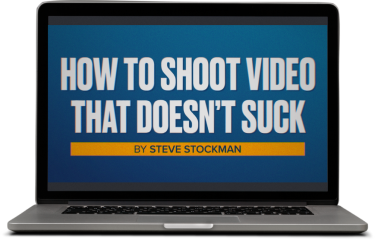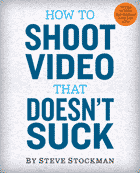From How To Shoot Video that Doesn’t Suck, Page 140
Imagine this video: At a retail in-store appearance in Hollywood, the costumed movie superhero steps out of the limo and walks through the store.
Shot from adult height, we see the character shake hands with the store manager and the tops of heads of children as we pass by. But if we kneel down to child level, suddenly we’re in another world. We see kids’ faces light up as this cartoon-come-to-life walks past, their anguish as they decide whether to approach, and their joy when they finally get a hug from their favorite star.
Changing the filming angle has completely changed the meaning of the video—as it often does. But most people shoot everything straight on at about chest level—right where it’s easy to hold the camera. Get used to playing with angles in your video, and everything will start to look more interesting.
Want to practice? Set a timer for 5 or 6 minutes and see if you can shoot 50 different static shots of one thing—no zooming or moving in the shot. Shoot 3 seconds. Cut. Move. Shoot 3 seconds. Cut. Speed is important. You don’t want to think too much or judge the results– it’s all about practice. Make your moves BIG. Don’t just step a little to the right, go behind your subject. Don’t lower the camera a little. Lie on the floor!
In this video, I shot 6 minutes while my daughter did homework for her art history class. I used a Kodak pocket camera, which means no zoom lens. Not all the shots are brilliant (and a couple aren’t in focus– I kept them in the non-judgmental spirit of the exercise) but they’re all less boring than another straight-on, eye-level shot.
Thanks to Chris Arena for the great song.

Get a free preview of the new video course!
Sample two lessons from our new video course free right now. No signup or credit card required!





 Steve Stockman is a writer/ producer/ director in Los Angeles. How to Shoot Video That Doesn't Suck, available in 9 languages, is the best selling video how-to book in the world. You can find the updated (2017) edition from Workman Publishing wherever you get books, ebooks or audiobooks.
Steve Stockman is a writer/ producer/ director in Los Angeles. How to Shoot Video That Doesn't Suck, available in 9 languages, is the best selling video how-to book in the world. You can find the updated (2017) edition from Workman Publishing wherever you get books, ebooks or audiobooks. 
Hi
I am new to videography
I ordered this book from Amazon in Germany, and I am very satisfied. I have panasonic GH4 that I am very happy, which lenses do you recommend?
Thank you
The same philosophy about buying cameras I recommend also applies to lenses. In summary: use what you have until you’ve learned enough to know what you need.
I just purchased the book on the store this week. IT'S AWESOMELY INSPIRING!! I'm not a film college student or anything, but i really into this movie making. Your book really put me (and everyone else reading your book) on the next level.
Thank you Steve.
Hi again Steve, As a teacher, I love to engage my students in quick and active activities to enhance their learning. This has enhanced mine a great deal. Thank you, almost finished reading the book. You have taught me so much.
Thanks again.
Thanks, Chris!
Wow. This was eye-opening.
I bought your book last week. Lot's of good stuff, but nothing sank in as much as this video. Thanks.
Thanks for the advice on the 180 degree rule. It actually makes a lot of sense. There's absolutely no confusion about where you are in relation to your daughter. I also like the natural shakiness (not jerkiness) about the video. There's almost an argument for not using a tripod in such instances.
Great stuff. Boring question #1: what camera did you use? Boring question #2: did you break the 180 degrees rule. Not that it matters because the video looks great, but did you?
I used a Kodak Pocket Video Camera– a simple point and shoot with a fixed lens.
As for the 180 degree rule: This “rule” suggests that you must keep your cameras all on the same side of a 180 degree line (imagine a circle split in half– the cameras go on one side of the split, the action on the other.) If you “cross the line”, the shots won’t cut together easily and the audience may be confused when characters move suddenly from the right to left side of the screen.
While this is still something to consider when shooting coverage in narrative film and TV, it’s not something I generally worry about in documentary, most commercials, or reality TV. Audiences understand camera moves better than they did in the early 20th Century, when this “rule” was etched into cinematic brains. It’s harder to confuse them now, and more sudden moves work. Even in narrative work, it’s not the rule that it once was– see Tarantino and many others for example.
Yes, I broke the 180 degree “rule” while shooting this, and you should too when you try it.
I just received the book this weekend. So, far the recommendations you provide make sense. I will start putting them into use….Ken
I would also like to thank you for all the tips in your book. I'm a teacher and high school soccer coach and I put together a 4 minute video for use at a pep rally assembly and it turned out great. I received a lot of compliments.
Great, Jorge. Glad it worked for you!
Just would like to thank you for simple excellent tips for video making. i really enjoyed reading your book SHOOT VIDEOS THAT DOESN'T SUCK and I must say I got my monies worth. Great job. Now it's time to apply the skills that I have learned and make some must-see-videos.
I agree. Excellent video. I'm going to try this project with my daughter. Thank you again, Steve, for excellent tips and for your passion for film.
This is excellent! I just purchased your book over the weekend and I'm sooo excited to try this exercise. Like the tips in your book, these website tips are very well-explained and simply make sense.
Thanks, Mimi! Looking forward to hearing how it goes!